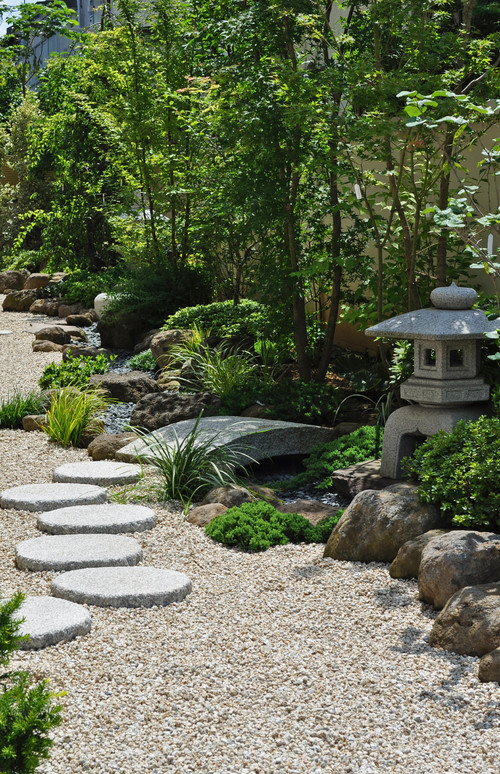
Many people are drawn to the minimalistic beauty and unmistakable feeling of calm in Japanese gardens. Drawing from centuries of tradition, a stunning natural landscape and a culture rich in ceremony, authentic Japanese gardens can be very difficult to re-create outside of the culture. Instead, look for inspiration from the design principles of balance and restraint and from some of the traditional elements of Japanese gardens.
Softscape
Much as a Japanese brush painting captures the essence of a landscape scene in a few brushstrokes, Japanese gardens emulate the natural world in a stylized way. The inspiration for plant choices, color and form come from the country’s native forests, lush streambeds and towering mountains. Dark stones, bright and deep greens and earthy browns and sandy tones are the most common colors, but many gardens also have one or two accents of red or other vivid hues. Further imitating the natural landscape, traditional Japanese gardens often include a subtle change in topography, such as mounds to symbolize hills or depressions for valleys.
Hardscape
Most Japanese gardens make use of naturalistic building materials like large stepping stones, bamboo, hardwoods, gravel and sand. Contemporary landscapes may combine the traditional materials with more modern ones like concrete and concrete aggregate.
Pathways, courtyards, planting beds and other garden elements are laid out to promote balance in the landscape. Unlike classical European gardens that favor symmetry, Japanese gardens often achieve balance through asymmetry. For example, if a large boulder is placed on one side of a pathway, a tree is often placed on the other to promote the balance of form.
Garden Elements
Teahouses. Traditionally, a Japanese teahouse surrounded by a naturalistic garden is a sacred space for conducting a tea ceremony. Although the ceremony itself may not be a part of your tradition, most of us can relate to the appeal of an outdoor room designated for peace, calm and reflection.
Water basins. Wash basins are important elements in teahouse gardens and are traditionally used by guests to cleanse themselves before entering the teahouse. A proper wash basin is surrounded by a careful arrangement of stones representing different elements. Basins with or without the traditional stones can be beautiful in their own right and act as a tranquil water feature in the garden. Adding a simple water basin to your garden can be one of the easiest ways to introduce a feeling of calm.
A representation of water. A sacred element across cultures, water — and the illusion of it — is celebrated in Japanese gardens and can have a soothing effect in a landscape design. To get the look in your own backyard, dig a shallow depression to act as a dry streambed and fill with dark gravel. Nestle rounded fieldstones along the banks and fill in with ferns and tufts of sweet flag (Acorus gramineus).
A representation of a mountain. Japanese gardens often have one or more large stones or boulders representing mountains in the landscape and anchoring the design. Boulders look more natural — and more like miniature mountains — when they are partially buried and have plants nestled around the base, or small shrubs placed nearby to relate to the size and scale of the stone.
Walkways designed to encourage contemplation. Many Japanese gardens have paths that meander through the space, crisscrossing streambeds — symbolic or real — and designed to guide a visitor on a meditative walk. To get the same effect on a smaller scale, incorporate a walkway made up of stepping stones. The stones will slow your path through the garden and encourage you to be present in the journey.
Rock gardens or Zen gardens. Originally designed as meditation gardens, dry landscapes made up of a composition of rocks, moss and small trees are also common elements of Japanese gardens. The pale sand or fine gravel spread to cover the ground represents water and is often raked into ripples. Even on a small scale in a home garden, these stylized landscapes can be very peaceful to gaze upon.
Plant Types
Japanese maples. The graceful branch forms and delicate leaves of Acer palmatum have long been cherished by Japanese gardeners. The trees stay relatively small — 15 to 25 feet, smaller with pruning — making them beautiful additions to smaller backyards or courtyard gardens. Choose from varieties with leaf colors ranging from chartreuse to plum.
Moss gardens. Areas blanketed with verdant moss and studded with ferns and stones are another element of traditional Japanese gardens. Some moss gardens in Japan have been in cultivation for hundreds of years. Moss thrives only in consistently moist, temperate conditions with not too much sun but also not in deep shade. Finicky as it is to grow, most home gardeners would be advised to create the same effect with a moss look-a-like such as baby’s tears (Soleirolia soleirolii).
Spring gardens. Traditionally associated with birth and renewal, spring is particularly revered in Japanese gardens. Most include plants like flowering cherries, chosen for their spring blossoms, as well as plants with bright, vivid green leaves that feel fresh and spring-like for much of their growing season.
Fall color. Japanese gardens also embrace seasonal change from summer to winter by including trees and shrubs that put on a fall show. To get the look, choose one stunning Japanese maple, such as Acer palmatum ‘Osakazuki’, which turns crimson in autumn, or plant a grove of brilliant gold ginkgo trees (Ginkgo biloba). Tip: To avoid cleaning up messy fruit drop, select a male ginkgo at the nursery.
EDITOR’S NOTE: This article was written by Lauren Dunec Hoang and is from Houzz. Hoang is landscape designer and was previously a garden editor for Sunset Magazine and in-house designer for Sunset’s Editorial Test Garden.


















